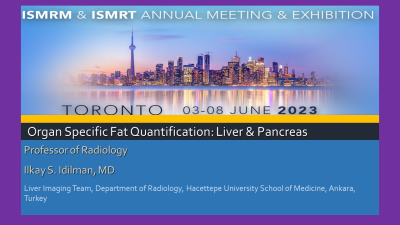Weekend Course
MRI Quantification of Fat: Techniques, Challenges & Clinical Implications
ISMRM & ISMRT Annual Meeting & Exhibition • 03-08 June 2023 • Toronto, ON, Canada

| 13:15 |
Technical Aspect of Fat Quantification
Timothy Bray
Keywords: Contrast mechanisms: Fat This talk will give an overview of methods for quantifying fat with MRI. MRI-based methods have emerged as valuable tools for assessing the fat content of tissue in a wide variety of organs and disease states, and can also provide fat-corrected measurements of other tissue characteristics such as relaxation times and diffusion coefficients. The basic principles of quantifying fat with MRI will be discussed, and methods for eliminating bias in fat quantification will be explained. Opportunities for future development including the inclusion of fat quantification within multiparametric acquisitions and the use of deep learning in fat quantification will be considered. |
|
| 13:45 |
Whole-Body Fat Quantification
Martin Buechert
Keywords: Cross-organ: Obesity, Cross-organ: Tissue characterisation, Image acquisition: Whole body As part of the course MRI Quantification of Fat: Techniques, Challenges & Clinical Implications, this session will focus on whole body fat quantification. An overview of the available modalities will be given before a closer look is taken at whole body fat quantification using magnetic resonance imaging. The second point of view will be from the perspective of different applications including clinical as well as research within epidemiological studies with large data sets. As a complement to the previous technical introductory course, we also consider fat-water MR spectroscopy. It can be used in addition to fat-water imaging for more precise local characterisation of adipose tissue. |
|
| 14:15 |
 |
Organ-Specific Fat Quantification: Liver & Pancreas
Ilkay Idilman
Keywords: Body: Liver, Cross-organ: Obesity, Cross-organ: Metabolic disease Organ-Specific Fat Quantification: Liver and Pancreas Hepatic steatosis is the abnormal accumulation of triglycerides in the hepatocytes whereas a fatty pancreas is the abnormal pancreatic fat accumulation. Both are shown to be associated with metabolic syndrome, Type 2 diabetes, and cardiovascular diseases. The main approach to quantifying liver and pancreas fat is chemical shift magnetic resonance imaging (MRI) techniques. MRI-proton density fat fraction (MRI-PDFF) is shown to be an excellent diagnostic value for the assessment of hepatic fat content and classification of histologic steatosis grades in non-alcoholic fatty liver disease. |
| 14:45 |
Break & Meet the Teachers |
|
| 15:05 |
Organ-Specific Fat Quantification: Epicardium
Markus Henningsson
Keywords: Cross-organ: Metabolic disease, Cardiovascular: Cardiac metabolism, Contrast mechanisms: Fat Epicardial fat is an early marker of many cardiovascular diseases, in particular atrial fibrillation, coronary artery disease and heart failure with preserved ejection fraction. This presentation will focus on current MRI strategies to assess epicardial fat. I will discuss technical challenges as it relates to imaging epicardial fat and highlight potential avenues for further technical and clinical research. |
|
| 15:35 |
Organ-Specific Fat Quantification: Skeletal Muscle
Young Cheol Yoon
Keywords: Cross-organ: Tissue characterisation, Musculoskeletal: Muscular, Contrast mechanisms: Fat The accumulation of lipids in skeletal muscle can lead to various health issues. Currently, semiquantitative methods like the Goutallier and Mercuri systems are used to evaluate fatty infiltration, but they have limitations. MRS is more reliable for measuring lipid content, but several factors must be considered during data acquisition. PDFF is an emerging technique that generates fat fraction maps, allowing for direct quantitative measurement of fat proportion. T2*-corrected six-echo Dixon sequences are recommended. PDFF is the most commonly used metric for estimating skeletal muscle quality, and studies have shown its usefulness in various clinical conditions, including sarcopenia and neuromuscular diseases. |
|
| 16:05 | Strategies for Optimizing the MRI Scanning of the Obese Patient Raul Uppot | |
| 16:35 |
Panel Discussion |
The International Society for Magnetic Resonance in Medicine is accredited by the Accreditation Council for Continuing Medical Education to provide continuing medical education for physicians.